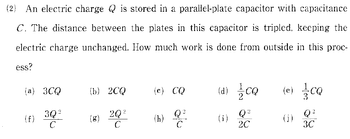Question
thumb_up100%

Transcribed Image Text:(2) An electric charge is stored in a parallel-plate capacitor with capacitance
C. The distance between the plates in this capacitor is tripled, keeping the
electric charge unchanged. How much work is done from outside in this proc-
ess?
(a) 3CQ
3Q²
(f)
(b) 2CQ
2Q²
C
(e) CQ
(h)
Q²
(d) //co
Q²
2C
(i)
(e) cQ
S
Q²
3C
Expert Solution
This question has been solved!
Explore an expertly crafted, step-by-step solution for a thorough understanding of key concepts.
Step by stepSolved in 2 steps

Knowledge Booster
Similar questions
- The drawing above shows a graph of a set of equipotential surfaces seen in cross section. Each is labeled according to its electric potential. A 3.3E-7 C point charge is placed at position A. Find the work that is done on the point charge by the electric force when it is moved (a) from A to B, and (b) from A to Carrow_forwardAn electron moving parallel to the x axis has an initial speed of 3.14 x 10° m/s at the origin. Its speed is reduced to 1.44 x 10 m/s at the point x = 2.00 cm. (a) Calculate the electric potential difference between the origin and that point. Volts (b) Which point is at the higher potential? O the origin O the point x 2.00 cm O both have the same potential Need Help? Read It Master Itarrow_forwardQ) Assume that the distance between A and B is 2m, and A and C is 4m in the Figure. Once a proton moves from A to B along an electric field line in the Figure, the electric field does 6.4x10- 19 J of work on it. The electric potential difference between B and A, and C and A is VBA and VCA, respectively. What is ratio of VBA / VCA? (Coulomb constant is 9x109 Nm²/C², Charge of proton is 1.6x10-19 C) Electric field line A) 0.5 B) 1 C) 2 D) 4 E) 8 Equipotentialsarrow_forward
- As seen in the figure the points A, B, C, and D are on the circle. O is the center and Ris the radius of the circle. Two charges Q, and Q are placed at points A and B, respectively. What must be the charge at C to have electric potential zero at point D. (VD =0)? (V = 0) A) (-3)(3-√3)Q B) (-3) (3+√3)Q c) (-) (2 + √2)Q D) (-) (2-√2)Q E) (-3) Q Darrow_forwardA parallel-plate capacitor has a capacitance of 2.3 µF and a plate separation of 1.7 mm. (a) What is the maximum potential difference between the plates such that dielectric breakdown of the air between the plates does not occur? (Use Emax = 3 MV/m.) kv (b) How much charge is stored at this maximum potential difference? mcarrow_forward(a) Find the electric potential, taking zero at infinity, at the upper right corner (the corner without a charge) of the rectangle in the figure. (Let x = 6.30 cm and y = 2.20 cm.)(b) Repeat if the 2.00-µC charge is replaced with a charge of −2.00 µC.arrow_forward
arrow_back_ios
arrow_forward_ios